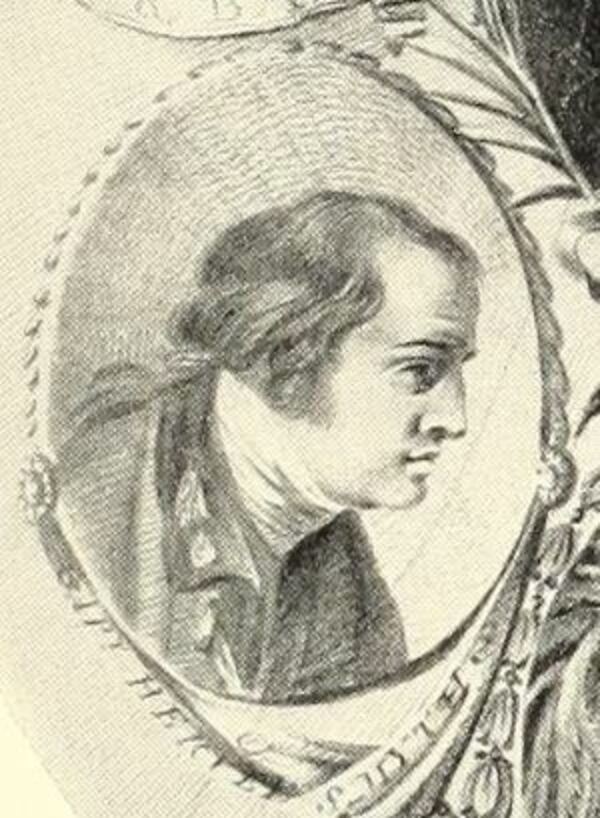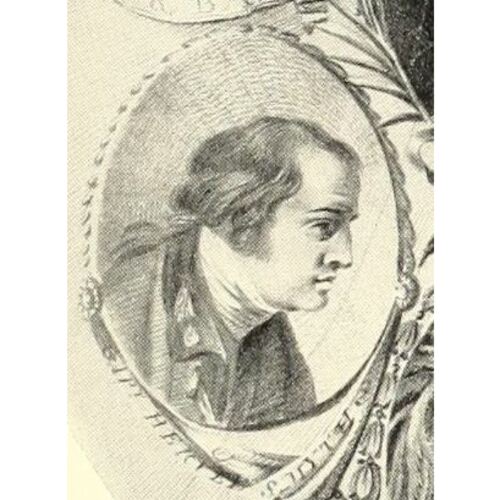As part of the funding agreement between the Dictionary of Canadian Biography and the Canadian Museum of History, we invite readers to take part in a short survey.

Source: Link
SMYTHE (Smyth), Sir HERVEY, army officer and topographical painter; b. 30 May 1734 in Ampton, England, son of Sir Robert Smythe and Lady Louisa Carolina Isabelle Hervey, daughter of John Hervey, 1st Earl of Bristol; d. unmarried 25 Sept. 1811 in Elmswell, Suffolk, England, and was buried at West Ham (London).
Hervey Smythe was a page of honour to George II before entering the Royal Horse Guards as a cornet at age 19. On 8 Nov. 1756, at the beginning of the Seven Years’ War, he became a captain in the 15th Foot and in 1758 he participated in the expedition against Louisbourg, Île Royale (Cape Breton Island), where he was slightly wounded. He won the admiration of Brigadier-General James Wolfe*, who wrote to Lieutenant-General Lord George Sackville on 30 July that “Little Smith . . . is a most indefatigable, active, and spirited man and has a just claim to your favour and friendship.”
On 4 May 1759 Wolfe appointed Smythe one of his aides-de-camp for the campaign against Quebec. The British force arrived at Île d’Orléans on 27 June and the siege of Quebec began. On 22 July Wolfe sent Smythe to Quebec under a flag of truce to escort a large number of women captured the previous day by Lieutenant-Colonel Guy Carleton during an attack on Pointe-aux-Trembles (Neuville). Wolfe, in a gesture of gallantry, had entertained at table on the evening of the 21st some of the group who were from distinguished families; he was angered, therefore, when his aide-de-camp was rudely received by Quebec’s besieged inhabitants and protested this treatment of Smythe to Lieutenant-General Louis-Joseph de Montcalm*. Nine days later Smythe participated in the disastrous attack at Montmorency Falls; on 13 September he was severely wounded in the battle of the Plains of Abraham, where Wolfe himself was killed. In his will Wolfe had left Smythe and several other officers 100 guineas each “to buy swords & rings in remembrance of their Friend.”
Smythe, probably because of his wound, returned immediately to England. With him he took a number of sketches he had made of places in the Gulf of St Lawrence and of battles during the siege of Quebec; along with Richard Short* and Thomas Davies he was one of the first military artists to record Canada visually. Smythe’s sketch of the attack on Quebec, engraved and published at London about 1760, became a popular print at the time. He had supposedly made a profile drawing of Wolfe shortly after the general’s death, and in London he painted profiles of Wolfe, which were reproduced in small mezzotints by the well-known engraver Charles Spooner. Smythe is chiefly remembered, however, for Six elegant views of the most remarkable places in the river and gulph of St Lawrence, engraved by various hands and published in London by Thomas Jefferys in 1760 with a dedication to William Pitt, secretary of state for the Southern Department. Oil paintings were subsequently executed of several of the same subjects, possibly by the English marine artist, Francis Swaine, Smythe’s contemporary.
Smythe became a captain in the 2nd Dragoon Guards on 13 Jan. 1760 and brevet lieutenant-colonel on 26 Nov. 1762. The following year he became a captain in the 3rd Foot Guards. His wound during the battle of the Plains had, however, impaired his health, and he retired on 12 May 1769. In 1783 he succeeded his father as baronet and, having passed the latter part of his life in continual suffering, he died in September 1811 at his farm at Elmswell.
[Hervey Smythe’s Six elegant views of the most remarkable places in the river and gulph of St Lawrence was reproduced in Scenographia Americana, or a collection of views in North America and the West Indies . . . (London, 1768). A profile of Wolfe, drawn soon after the general’s death, was attributed to Smythe, but John F. Kerslake, in “The likeness of Wolfe,” Wolfe: portraiture & genealogy (Westerham, Eng., 1959), 42, emphasizes that the identity of the artist has not been established beyond doubt. A tracing of this sketch is held by the National Portrait Gallery, London. Francis Swaine is credited with some canvasses painted from sketches by Smythe of scenes along the St Lawrence River and in the gulf area. Two of these canvasses are in the Royal Ontario Museum, Toronto, and two others are at the National Gallery of Canada in Ottawa. The latter two, A view of Gaspé Bay and A view of Miramichi, are unsigned and their attribution to Swaine is based only on the word of Smythe himself.
Charles Perry Stacey in “Quebec, 1759: some new documents,” CHR, 47 (1966): 345, advances the view that either Smythe or Thomas Bell was the author of a “pungent and literate” account of the Quebec campaign. The original is in the Dobbs papers at the Public Record Office of Northern Ireland (Belfast), D 162/77, and on microfilm at the PAC.
The claim has been made that Hervey Smythe was the young officer portrayed at the centre of Benjamin West’s painting The death of Wolfe (1771). A drawing from West’s studio, comprising portraits of figures depicted in this well known canvas, contains one of Smythe that is reproduced in Annie Elizabeth Wolfe-Aylward, The pictorial life of Wolfe (Plymouth, Eng., n.d.), 79. Reproductions of another portrait of him are at the PAC and in Knox, Hist. journal (Doughty), 1: 331–32, 440. r.h.h.]
Suffolk Record Office (Bury St Edmunds, Eng.), Ampton, Reg. of baptisms, marriages, and burials, 1734. Bury and Norwich Post (Bury St Edmunds), 2 Oct. 1811. Examiner (London), 20 Oct. 1811. Allgemeines Lexikon der bildenden Künstler von der Antike bis zur Gegenwart . . . , ed. Hans Vollmer (37v., Leipzig, German Democratic Republic, 1907–50), 31: 185. A catalogue of the Sigmund Samuel collection, comp. C. W. Jeffreys (Toronto, 1948), 10, 17–24, 118, 144, 149. Complete baronetage, ed. G. E. Cokayne (5v., Exeter, Eng., 1906), 5: 24. The National Gallery of Canada, catalogue of paintings and sculpture, ed. R. H. Hubbard (3v., Ottawa and Toronto, 1957–60), 3: 285. A. G. Doughty and G. W. Parmelee, The siege of Quebec and the battle of the Plains of Abraham (6v., Quebec, 1901), 2: 10, 115, 153, 311–12; 3: 221. J. R. Harper, Painting in Canada, a history (Toronto and Quebec, 1966), 41, 429. D. A. Ponsonby, Call a dog Hervey (London, 1949), 182–84. Robin Reilly, The rest to fortune; the life of Major-General James Wolfe (London, 1960), 191. F. St G. Spendlove, The face of early Canada: pictures of Canada which have helped to make history (Toronto, 1958), 7–8, 10, 82; plates 16–21. J. C. Webster, Wolfe and the artists; a study of his portraiture (Toronto, 1930), 34, 42–43. Beckles Willson, The life and letters of James Wolfe . . . (London, 1909), 388, 431, 453. C. P. Stacey, “Benjamin West and The death of Wolfe,” National Gallery of Canada, Bull. (Ottawa), (1966): 1.
Cite This Article
R. H. Hubbard, “SMYTHE (Smyth), Sir HERVEY,” in Dictionary of Canadian Biography, vol. 5, University of Toronto/Université Laval, 2003–, accessed March 26, 2025, https://www.biographi.ca/en/bio/smythe_hervey_5E.html.
The citation above shows the format for footnotes and endnotes according to the Chicago manual of style (16th edition). Information to be used in other citation formats:
| Permalink: | https://www.biographi.ca/en/bio/smythe_hervey_5E.html |
| Author of Article: | R. H. Hubbard |
| Title of Article: | SMYTHE (Smyth), Sir HERVEY |
| Publication Name: | Dictionary of Canadian Biography, vol. 5 |
| Publisher: | University of Toronto/Université Laval |
| Year of revision: | 1983 |
| Access Date: | March 26, 2025 |



